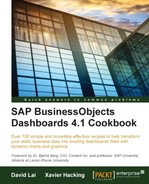SAP BusinessObjects Dashboards provides an easy-to-use selector component for hierarchical data. For example, we may have a hierarchy that consists of a Region, Sales District, and Sales Office. We can easily create this with the Filter component.

It is important to set up the data as shown in the following screenshot so that the Filter component can consume it properly. Every row has to have values for the Region, Sales District, and Sales Office as well as the metric value(s) that you want populated on your destination. We have highlighted the destination in F3 and the filter-related stuff in A3:C6 and D3:D6. Information on how everything works can be found in the How it works... section.

- Add a Filter component from the Selectors category onto the canvas. In the Properties window, set Number of Filters to 3 since our hierarchy has three levels.

- Bind the Source Data to the area in green (A3:D6) from the data setup in the Getting ready section.
- Bind the Titles section to cells A2:C2.
- Bind the Destination to the cell F3.

- Insert a Label Text object into the canvas and bind it to destination cell F3.
- Preview and make sure the Filter component works.
The Filter selector component works by grouping values in each column of the source data. In our example, we selected three filters, so the first three columns of the source data will consist of the three hierarchies. The main parent is Region, which then branches down to District, and finally Office.
Now that we are familiar with the cells colored in blue from the image in the Getting ready section of this recipe, we'll explain what the cell in yellow is. The destination cell F3 can be of arbitrary width and will consist of metrics or values associated with the chosen hierarchy combination. For example, if we select East | District 1 | Office 1, it will retrieve the values corresponding to that combination row.
Note that the destination width is the same as the second part of the source data (D3:D6), which in our case is one column.
The Filter component isn't the only way to select from a hierarchical approach. We can also try a more advanced method found in the next recipe, An alternative hierarchy selection method, which will show the hierarchies in a set of list boxes. This may be the preferred approach if a user wants to see more than one value at a time. In addition, the recipe Presenting micro charts in a Tree Grid, found in Chapter 10, Top Third-party Add-ons, will show users how a third-party component can accomplish a hierarchy selection using the familiar Windows tree explorer.
